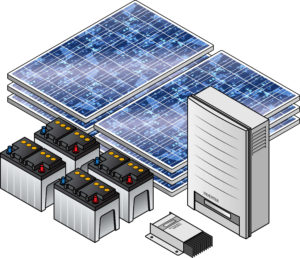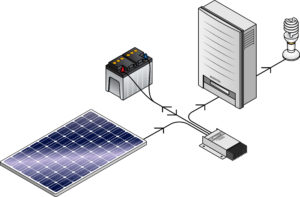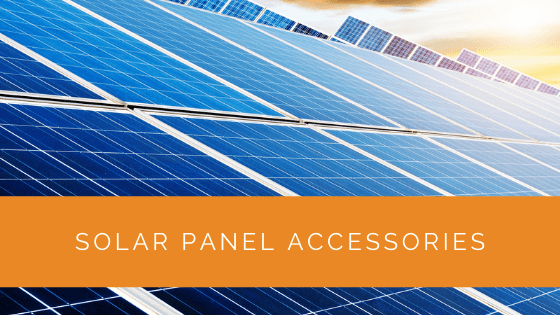Solar power has emerged as a prominent player in the renewable energy landscape as the world transitions towards cleaner and more sustainable energy sources. Harnessing the abundant energy from the sun, solar panels have become a key solution to reducing carbon emissions and lowering electricity costs. However, the efficiency and effectiveness of solar panels rely not only on the panels themselves but also on a range of essential Accessories.
In this article, we will explore the world of solar panel accessories, exploring the crucial elements that complement solar panels to maximize their energy production. Whether you are a novice in the field of solar energy or a seasoned enthusiast, understanding these accessories is vital for harnessing the full potential of your solar power system. Each accessory plays a significant role in ensuring a seamless and sustainable energy solution for your home or business, from inverters to mounting systems, solar cables, and monitoring technology. Let’s unravel the intricacies of these essential components and empower you to make the most of your solar power investment.
Contents
- 1 Key Takeaways
- 2 What are Solar Panel Accessories?
- 3 Types of Accessories in Solar Panel Kits
- 4 Case Study: Enhancing Solar Power System Efficiency with Key Accessories
- 5 Expert Insights From Our Solar Panel Installers About Solar Panel Accessories
- 6 Experience Solar Excellence with Us!
- 7 Make the most of your hybrid solar power systems!
Key Takeaways
- Solar panel accessories are essential components that enable the efficient functioning of solar power systems, converting sunlight into electricity.
- Important solar panel accessories include solar panels themselves (available in various sizes and types), inverters (to convert DC power to AC power), net meters (for grid-connected systems), mounting and racking systems, cables, connectors, and wires, solar batteries, monitoring technology, balance of system components (such as junction boxes and circuit breakers), charge controllers (for systems with batteries), and AC/DC disconnects.
- Understanding and utilizing these solar accessories can help maximize the benefits of solar power systems, such as cost savings and environmental benefits.
What are Solar Panel Accessories?
Coal, wood, and biofuels were the dominant energy sources a few years ago, with renewable energy coming in a close second. Renewable energy sources such as solar, hydro, and wind power are now replacing traditional energy sources. Solar energy is a free and renewable source of energy obtained every day from the sun’s rays.
Solar panels are photovoltaic devices that capture the sun’s rays and convert them to power or heat. On the surface of these panels, these solar cells are organized in a grid-like arrangement. Solar panel accessories are elements that allow you to mount and collect energy from solar panels correctly. Solar panels, often known as ‘photovoltaic’ panels, produce electricity by converting solar energy into DC power.
Each solar equipment mentioned below aids in collecting and moving energy from the sun to the battery, which stores the energy for later use. Solar panels can be installed on the ground, roof, or wall, but they must be installed at the correct angle to produce their peak current. Outdoor technologies must be able to withstand various weather conditions.
Types of Accessories in Solar Panel Kits
The most crucial solar panel accessories that every beginner in the solar energy field should know are enumerated below. To generate and conserve electricity from the sun, these components operate together. You can develop a seamless, sustainable energy solution with each and every piece of solar equipment we’ve talked about here.
Solar Panels
Solar panels come in a variety of sizes and watt capacities. The most common power supply in houses and RVs is 250 watts, but 100 watts, 300 watts, and 400 watts are all available. Panel sizes typically relate to the panel’s wattage rating instead of physical properties.
Monocrystalline or polycrystalline panels are available, with monocrystalline panels being more efficient. The majority of PV modules are 12V or 24V. However, 36V, 40V, and other voltages are also available. Both flexible and rigid solar panels are available in the market.
Rigid panels are more powerful and long-lasting. Flexible or thin-film ones, conversely, are more lightweight and can be used on sloped roofs. The technology type you select will define the racking mount you’ll need.

Inverters
Inverters, or Converters, take DC power from a solar panel and transform it to AC power. The subsequent power can then be sent to a breaker or other system component and used typically. In specific off-grid energy systems, inverters are placed after the charge controller and battery bank.
Inverters exist in various sizes and employ a range of technologies to improve the efficiency of the function of producing AC electricity. Micro inverters, central inverters, battery-based inverters, and string inverters are the most prevalent. Mechanical and technical features vary from one to the next.
Micro inverters are generally installed to the back of each panel to convert energy per module into AC power, but a string inverter can be arranged for a row of solar panels to link to one of the multiple strings inside the inverter to handle a succession of modules.
String inverters function by using ‘strings’ to connect your solar panels. Following that, the strings are linked to a single inverter. Micro inverters, on the other hand, link each panel with its own inverter. Micro inverter systems are linked in parallel rather than in series, as string inverters are. Each type of inverter, be it a micro inverter or a string inverter, has its advantages and disadvantages, and its technologies are tailored to specific applications in particular situations.
Net meter
If your utility supports net metering, a net meter is an essential component of a solar power system connected to the power grid. Any solar electricity you produce and don’t consume is sent to the grid if your utility provider supports net metering and you have a grid-connected solar panel, with or without a battery. Your utility will reimburse you for the electricity you produce through net metering, lowering your electric cost.
A specific electric meter, known as a net meter is necessary to record how much electricity your solar panels create vs. how much electricity you consume from the utility. Off-grid solar modules do not require a net meter because they are not linked to the utility.
Mounting and Racking Systems
Racking and mounting equipment in a solar system guarantee that a PV module is attached to the ground or a roof and comprises several critical elements that make up a complete racking system.
To create a complete racking and mounting system, most racking systems will utilize a combination of Tilt Legs, Braces, Wire Clips, Lugs, Rails, Attachments, Mounting Brackets, Splice Kits, End Caps, Flashings – and other pieces of equipment. To be installed on land, ground mount technology necessitates concrete and steel piping and a full racking kit.
Racking and mounting are critical components of any solar power system. To ensure that the solar system maintains coherence and can run for an extended duration, both roof-top and ground-mounted arrays must be mounted on a solid and sturdy framework.
Solar Cables, Connectors, And Wires
The numerous components of a solar power system are connected through wiring, cables, and connectors. Energy is sent from the photovoltaic panels to the charge controller, battery, and inverter via the connectors. Insulated copper or aluminum wire is used in solar power systems. Colors are used to distinguish between positive and negative cables.
Solar connections come in various sizes, but the most common is the MC4. MC4 connectors and the necessary crimping pieces of equipment are generally included in solar equipment packages. If you buy a solar panel kit, you’ll almost certainly have all the necessary connectors and wiring. Different layouts necessitate various cables and wiring.
Solar batteries
Solar batteries can be connected to your solar panel system to store energy for later usage or nighttime consumption. Storage batteries also enable a PV system to function when the grid is unavailable. You’ll need to couple your solar panels with a solar battery if you want them to work during a power outage.
Solar energy storage is used in both hybrid and off-grid solar systems. On the other hand, Off-grid systems require larger storage batteries because they don’t have the grid to rely on like hybrid systems.

Monitoring Technology
Monitoring Equipment components are usually linked to a contemporary inverter manufacturer. They use proprietary software to view and send system energy data analytics to an in-product interface or a web-connected device. Parts of monitoring equipment can be embedded into an inverter or attached to another solar array component in some cases.
Monitoring technology may display data on everything from the quantity of energy generated by solar panels to real-time data, rapid fault identification and troubleshooting, and energy yield statistics over a while.
A comprehensive Monitoring system can benefit the system operator to understand better the way the solar energy system is operating. Monitoring systems assist the utility company in drawing measures that can be taken to increase yields better, productivity, maintenance, efficiency, and other variables in real-time or throughout the system’s lifespan.
Balance of System
The Balance of System (BOS) of a PV module offers supplementary controls. Junction boxes, circuit breakers, AC/DC disconnects, loaders, combiner boxes, and fuses are the main types of modules found in a BOS. Because some setups require more distribution controls than others, each solar panel system will have its own BOS.
All BOS, on the other hand, have built-in safety features. The sort of BOS that must be used will be specified in your solar power package.
Charge controllers
Charge controllers are exclusively used in solar power systems with batteries. A charge controller is not required for grid-tied systems without batteries. Between the solar panels and the battery, charge controllers are designed to stop the batteries from being overloaded and guarantee that the battery is charged at the correct voltage level.
Batteries can catch fire if they are overheated; thus, a charge controller is necessary to ensure that your battery system is secure and long-lasting.
AC and DC Disconnects
These are mechanical switches that can turn off an inverter’s electricity. A power panel is built into many inverters, albeit the design structure fluctuates. Certain inverters lack a disconnect, and they must be purchased separately. Check your inverter’s documentation to see which type of Alternating Current/Direct Current disconnect you should use.
Case Study: Enhancing Solar Power System Efficiency with Key Accessories
Background
At Solar Panels Network USA, we recently completed a project aimed at enhancing the efficiency of an existing residential solar power system. The homeowner sought to improve their system’s performance by integrating essential solar panel accessories. This project demonstrates how the right accessories can maximize energy production and ensure long-term reliability.
Project Overview
The homeowner had an existing solar power system but noticed that it was not performing to its full potential. After a thorough assessment, we identified several key accessories that could enhance the system’s efficiency and longevity. The goal was to implement these accessories to optimize energy production and storage.
Implementation
The project involved the integration of various solar panel accessories, each chosen for its ability to address specific performance issues and improve overall system efficiency.
Key steps included:
- Initial Consultation and Assessment: We conducted a detailed assessment of the existing system to identify performance bottlenecks. The consultation also included educating the homeowner on the benefits of each accessory.
- Selection of Accessories: Based on the assessment, we recommended the installation of high-efficiency inverters, a robust mounting and racking system, solar batteries for energy storage, and advanced monitoring technology.
- Installation: Our skilled technicians installed the selected accessories, ensuring seamless integration with the existing solar panels. The installation process focused on optimizing the placement and connection of each component to maximize efficiency.
- System Integration and Testing: After installation, the entire system was thoroughly tested to ensure all components were functioning correctly and efficiently. We also set up the monitoring technology to provide real-time data and performance analytics.
Results
The integration of these solar panel accessories resulted in significant improvements in the system’s performance and reliability. The homeowner experienced increased energy production and better energy storage capabilities.
- Enhanced Energy Efficiency: The new inverters improved the conversion efficiency from DC to AC, resulting in more usable power for the household.
- Improved Stability and Durability: The upgraded mounting and racking system ensured that the panels were securely positioned for optimal sunlight exposure, enhancing their stability and durability.
- Increased Energy Storage: The addition of solar batteries allowed the homeowner to store excess energy, providing a reliable power source during nighttime and cloudy days.
- Real-Time Monitoring: The advanced monitoring technology provided real-time data on system performance, enabling the homeowner to track energy production and consumption more effectively.
Summary
This case study highlights the importance of selecting the right solar panel accessories to enhance the efficiency and reliability of a solar power system. By integrating high-quality inverters, robust mounting systems, solar batteries, and advanced monitoring technology, Solar Panels Network USA helped the homeowner achieve significant improvements in their energy production and storage capabilities. Our commitment to quality and sustainability ensures that we continue to support our clients in optimizing their solar power investments.
Expert Insights From Our Solar Panel Installers About Solar Panel Accessories
Solar panel accessories are essential for maximizing the efficiency of your solar power system. Understanding the role of each component helps ensure you’re getting the most out of your investment.
Senior Solar Installer
Inverters are critical in solar power systems. They convert the DC power generated by solar panels into AC power, which is what most household appliances use. Choosing the right inverter can significantly impact the overall performance of your system.
Lead Solar Technician
Proper mounting and racking systems are vital for the stability and longevity of solar panels. These accessories ensure that your panels are securely installed and positioned for optimal sunlight exposure.
Chief Installation Engineer
Experience Solar Excellence with Us!
Trust in Solar Panels Network USA, where our seasoned experts deliver top-quality solar solutions for homes and businesses nationwide. With a legacy of countless successful installations and a commitment to sustainable energy, we’re your reliable partner in the solar journey. Ready for a brighter, eco-friendly future? Call us now at (855) 427-0058 and harness the power of the sun!
Make the most of your hybrid solar power systems!
More and more people are opting to install residential solar power systems worldwide. Their goal is to save money on electricity in the long run while reducing their carbon footprint. Installing solar panels on your property is an investment, and it only makes sense to make the most of it.
If you are considering purchasing a solar power system, take the time to learn about the components that make up a solar panel kit and how they function together to generate electricity to meet your energy demands.
Each solar equipment mentioned above allows you to enhance your cost-cutting potential while improving the environment’s safety.
About the Author
Solar Panels Network USA stands at the forefront of solar energy solutions, driven by a team of seasoned solar engineers and energy consultants. With over decades of experience in delivering high-quality solar installations and maintenance, we are committed to promoting sustainable energy through customer-centric, tailored solutions. Our articles reflect this commitment, crafted collaboratively by experts to provide accurate, up-to-date insights into solar technology, ensuring our readers are well-informed and empowered in their solar energy decisions.

